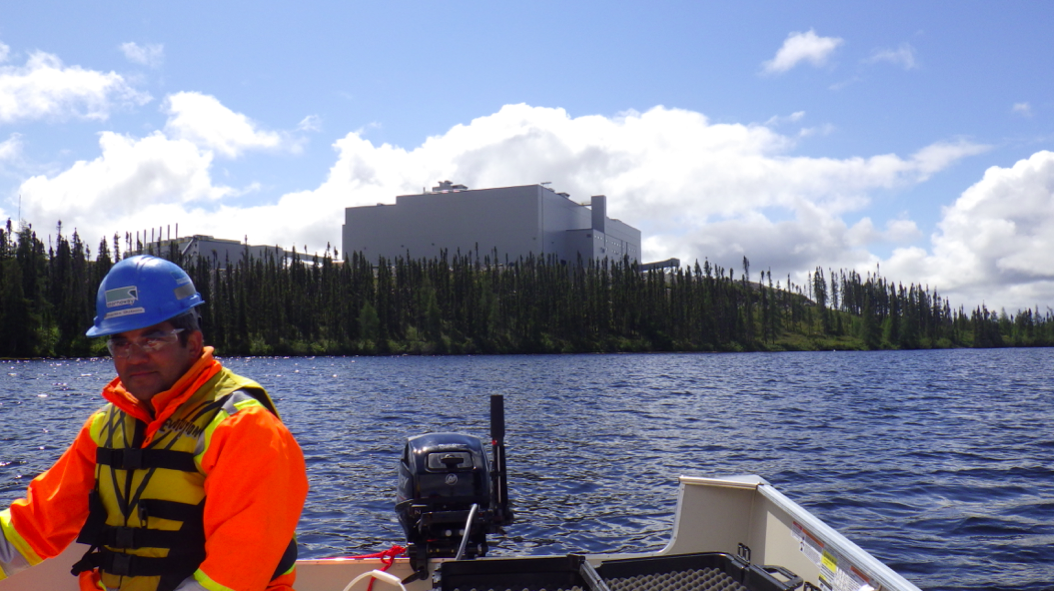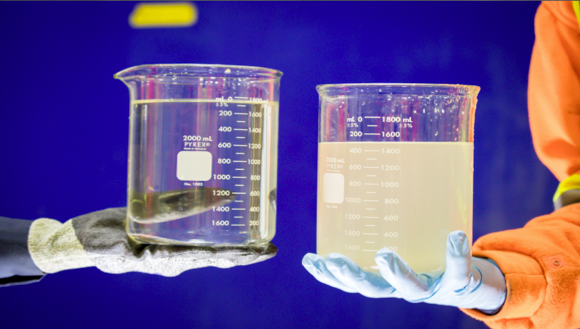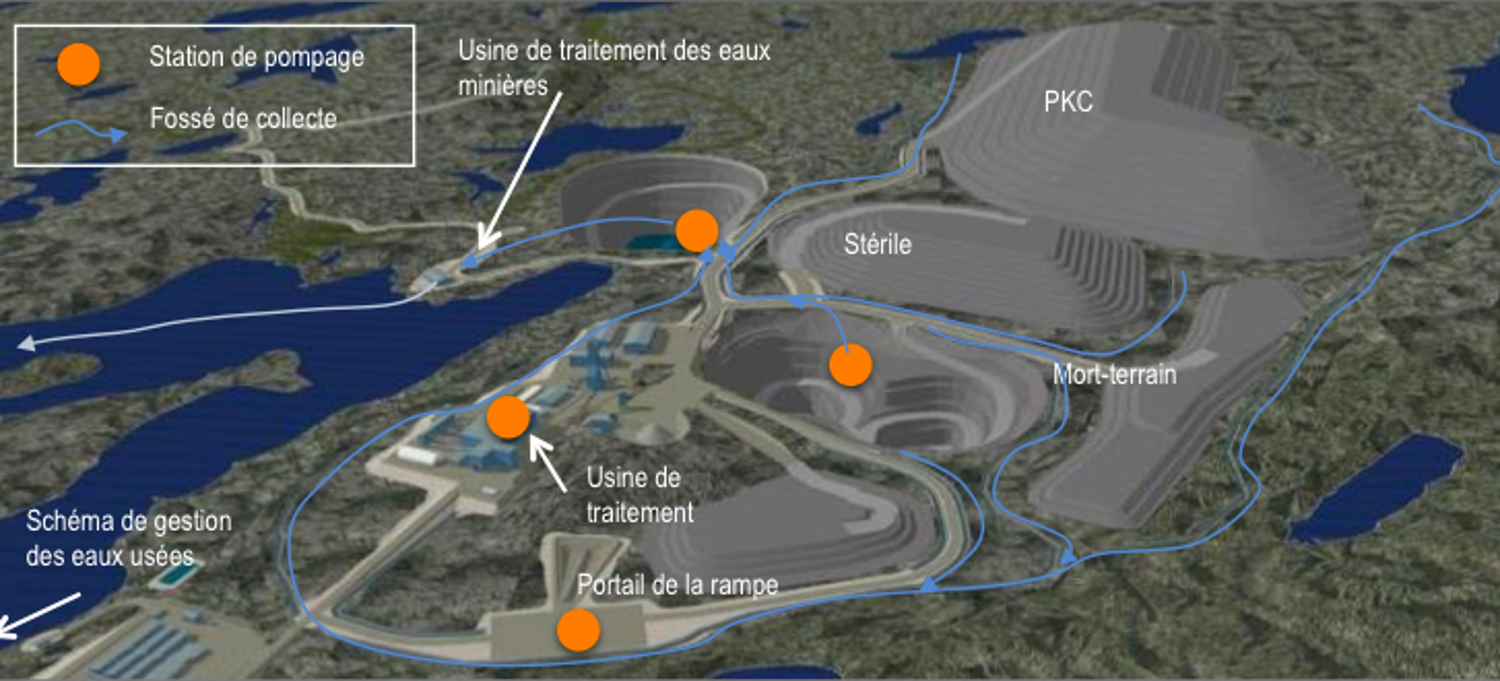Yes, that’s right!
At the start of the Renard project, Stornoway decided that the mine would have as little impact as possible on water quality. How did the Stornoway team achieve its goal? Read on.
Water is needed to supply an ore treatment plant, and generally it is drawn from nearby lakes and watercourses. In other words, fresh water is used. Remarkably, Stornoway does not use any fresh water at all, but only runoff from the mine site and the product of dewatering operations in the underground mine. All of this water is recycled, and is available in sufficient quantities to supply the ore treatment plant. Lac Lagopède, and six other lakes and streams close to the mine infrastructures, are not affected by large-scale water withdrawals. Only drinking water for the mining camp is taken from Lac Lagopède. The picture shows environment technician Charles Dubois on Lac Lagopède and, in the background, the ore treatment plant.
The picture shows environment technician Charles Dubois on Lac Lagopède and, in the background, the ore treatment plant.
When, at the end of the process, the water is returned to the environment after its journey through the wastewater treatment plant, it is of the highest quality. Regular analyses show that the treated water easily meets industry standards and the environmental emission objectives established by the Ministère du Développement durable, de l’Environnement et de la Lutte contre les changements climatiques (MDDELCC).

This outcome results from a comprehensive approach launched as soon as work began to construct and commission the Renard Mine in 2014. When construction activities commenced on the site, Stornoway built a temporary water treatment plant. All runoff, and all water that had come into contact with the mine site, was treated there until April 2016, when the brand-new permanent water treatment plant came into action.
In addition to treating meltwater that has been in contact with the mine site, the plant treats runoff and surface drainage water, and water from dewatering operations in the open-pit and underground mine. Stornoway has even dug ditches around the whole of the site to contain all the water that comes into contact with the mine. The ditches also ensure that runoff that has not come into contact with the mine site can be diverted, reducing the volume of water requiring treatment.
Stornoway set itself the challenge of ensuring that its activities
would have the lowest possible environmental impact.

The same exemplary approach used for drinking water and domestic wastewater
It is easy to understand that with almost 400 workers living on-site, a considerable quantity of wastewater is produced. Before being discharged into the environment, this domestic wastewater is treated in a plant equipped with cutting-edge technology. “We built an ultra-modern, highly automated facility” explains Martin Boucher, Stornoway’s Vice President for Sustainable Development. The equipment is so modern that operations can even be monitored from a distance. “It’s as if the various plant components could talk to the technicians,” he adds.
The plant exceeds MDDELCC requirements for domestic wastewater treatment. It is one of the most modern facilities in Québec, even though Stornoway is not a municipality but a mining company.
For drinking water, Stornoway’s unrelenting focus has produced outstanding results. To date, no notices have been issued to boil or avoid drinking the water. In addition, no analysis results have shown the presence of micro-organisms indicating fecal contamination or coliform bacteria.
Voluntarily and to ensure transparency, Stornoway has introduced a program to monitor drinking water quality that meets the requirements of the Regulation respecting the quality of drinking water, the Regulation respecting occupational health and safety, and the certificate of authorization issued by the MDDELCC. It is important to note that the Regulation respecting the quality of drinking water does not impose a specific monitoring program on companies—in other words, Stornoway has gone beyond the regulatory requirements in order to preserve its workers’ health.
Other environmental initiatives
Wherever there is machinery, there is oil, which can escape to the environment in many different ways. Stornoway has taken steps to prevent any kind of spill, and has installed equipment to separate oil from water. These oil separators receive wastewater from the mechanical repair workshop and the airport hangar. Oil floats to the surface, where it is recovered and stored in special containers before being taken off-site to be recycled.
Groundwater
Stornoway has also implemented a program to monitor groundwater quality, as required by the MDDELCC around high-risk sites and trench landfills. At Renard Mine, 42 observation wells have been dug to monitor groundwater closely. They cover the entire mine site and the area around the landing strip.
Respect for the host environment: a shared concern
The environmental and social management system (Système de gestion environnementale et sociale, or SGENVS) established by Stornoway also deserves attention. It was created when work began with one key objective: to allow Stornoway to respect its commitments.
The SGENVS includes
- an environmental and social monitoring program;
- a work permit, known as an “Éco-Permis”, to improve the monitoring of work;
- an environmental monitoring plan for construction work.
Every contractor working on the site must obtain an “Éco-Permis” before beginning any work that may affect the environment.
As Martin Boucher explains, “we have ensured that contractors and workers understand and implement Stornoway’s goal of maintaining the worksite in immaculate condition and respecting the host environment.”
An exemplary approach
Stornoway has applied an exemplary approach since the start of the 2000s.
It has informed the local communities and held numerous consultation sessions. The population has had an opportunity to make its concerns known, and a working group on the environment has been set up with the Cree community of Mistissini. The working group’s interventions have ensured improvements to the project at all stages in its development.
Stornoway opened an office in Mistissini in 2011, as the best way to maintain a dialogue with the main stakeholders. The Mecheshoo Agreement, signed in 2012, sealed the collaboration between Stornoway and the Crees. Discussions about environmental matters—and the search for sustainable solutions—have continued within the framework provided by the Agreement.
In July 2012, Stornoway signed a “Partners’ Declaration” with the host communities of Chapais and Chibougamau. It provides a way to respond to problems and initiatives of joint interest, such as communications, employment, economic diversification and the attraction of new workers to the region.
In short, Stornoway has done everything possible, and even a little more, to ensure respect and support for its host communities. The results are convincing, whether in environmental or social terms!
